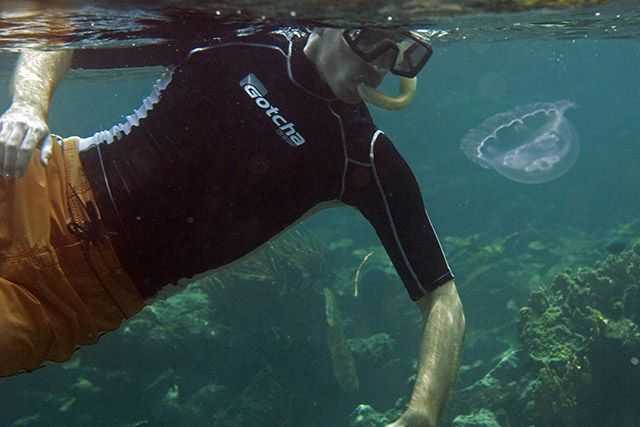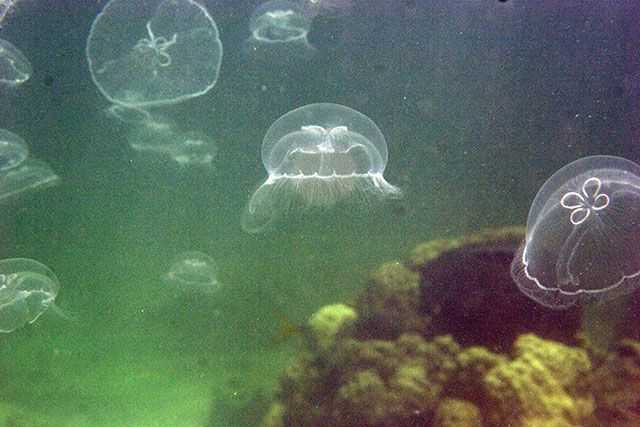
In a program at our Coastal Center about leatherback sea turtles, I consistently get a round of applause when I announce that 95% of their diet is jellyfish – you have to love a turtle that eats jellyfish. Although people generally dislike jellyfish, particularly while swimming, diving or fishing, we are still fascinated by them and love to see them safely tucked behind glass at an aquarium. Oftentimes gelatinous animals are lumped together into what we call jellyfish, but there are in fact a variety of animals, none of which are fish, that are transparent and planktonic drifters, so “jellies” is more appropriate.
Our classic idea of the jelly is that of a dome with tentacles that have venomous stinging cells. This animal is actually phase one of a two-part life history, in biology texts referred to as the medusa phase. The second part of it begins when jellies spawn and the fertilized eggs develop into larvae, a.k.a. sea lice, as the microscopic larvae are similarly endowed with stinging cells. The larvae settle on the bottom growing into what is referred to as the polyp phase. Miniature medusas eventually bud off of the polyp and enter the water column, the cycle continues as they grow and reproduce.

A second variation of the gelatinous animal is the siphonophore, the most notorious example of these being the Portuguese Man of War. Each individual is actually a colony of animals, each animal specialized to function for the colony in one of the following ways: feeding, reproduction, protection (these have stinging cells) or buoyancy (the gas float, which visually identifies the Portuguese Man of War). Another example is one of the longest animals in the world; the Giant Siphonophore can measure up to 160 feet long.
The ctenophore, commonly called a comb-jelly, is another gelatinous animal that is defined by having rows of ciliated comb plates that gently move it through the water. Instead of stinging cells, these jellies have sticky tentacles to gather their food. Most are considered harmless but there are some species that have the ability to take the stinging cells from a prey animal into their own tissues for defense.
And then there are salps, transparent like a jellyfish but because in their larval stage they have a rudimentary nerve cord, they are actually more closely related to vertebrates than the spineless invertebrates. They can be single solitary swimmers no bigger than a fist or colonial groups bigger than a motorhome and they do not sting.

Evidence suggests that all types of jelly populations are growing. Increases in clogged intakes at coastal power plants and fisher’s nets rendered unusable are clear indications that something is changing. A study published in April of 2012 by Brotz et al., looked at their abundance in 45 Large Marine Ecosystems (LMEs). In the Northeast US Continental Shelf LME there is a high certainty that indeed jellies are increasing. For the Southeast US Continental Shelf LME there is not as much certainty, but the study indicates high increases there as well. Over 60% of the surveyed areas showed increases and less than 10% showed decreases in populations but keep in mind that the historical data on the populations of jellies is sparse so this is just the beginning of understanding their population dynamics.
Although invasive jelly species were present in almost half of the LMEs analyzed, they were not credited for the increases. It is more likely that increased nutrient loading, climate changes affecting oceanic temperatures or overfishing of their predators may be causing the increase in numbers. Due to the planktonic nature of these species, shifts in ocean currents could significantly affect their distribution, but it is unclear whether we have sufficient data to state that one LME’s increase was attributable to another’s decrease.
In the meantime, we may be seeing more jellyfish on our coastal doorsteps, and not just sea turtles but fish, crustaceans, mollusks and birds have all been known to make a meal of them. If you are considering trying them yourself in the tradition of the far east, a serving size is roughly 3.5 ounces, the protein is a decent 5.5 grams, but watch out for that high sodium, it’s over 400% of your daily allowance. Like mushrooms, I highly recommend that you leave their preparation to the professionals and stay away from the species with toxic cells, puffy lips are so twentieth century.